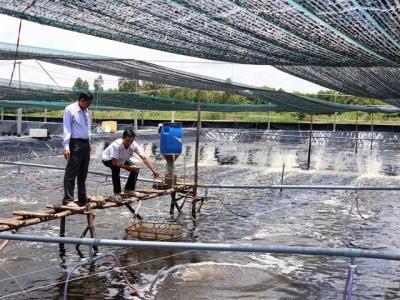Cà Mau eyes expansion of efficient farming, forestry models

CÀ MAU - The Cửu Long (Mekong) Delta province of Cà Mau is expanding all its efficient agriculture, fishery and forestry models.
A super intensive shrimp farming pond in Cà Mau City’s Hòa Tân Commune. – VNA/VNS Photo Kim Há
On the People’s Committee’s instructions, the expansion focuses on the province’s key produce, especially shrimp.
Cà Mau, the country’s largest producer of the crustacean, also counts rice and acacia among its key products.
Models like intensive and super-intensive shrimp farming and shrimp – rice farming have fetched farmers high incomes in recent years.
The super-intensive model offers average yields of 40-50 tonnes per hectare per crop and incomes of up to VNĐ80-100 million (US$3,400-4,300).
The country’s southernmost province has around 300,000ha of aquaculture farms, mostly shrimp, and these impact the lives of around 600,000 people, or more than 50 per cent of the province’s population, according to its Department of Agriculture and Rural Development.
The province breeds mostly black-tiger shrimp and white-legged shrimp.
The model of rotating shrimp and rice in a field offers steady incomes for farmers since it is not affected by climate change and is environment-friendly.
Under the model, farmers breed shrimp in the dry season and grow rice in the rainy season.
Besides, a large number of farmers in Thới Bình District also breed giant river prawns and grow rice simultaneously in their fields, and this model fetched them large incomes last year.
Lư Hải Đăng of the district's Tân Bằng Commune said he harvested nearly 1.2 tonnes of the prawns from his 3ha of rice field last year, earning VNĐ200 million ($8,560) after raising them for six months.
Thới Bình had 16,200ha of farms with giant river prawns last year, up nearly 7,000ha from the previous year.
Shrimp and rice produced under the model are clean since farmers do not use chemicals or pesticides.
The province's Department of Agriculture and Rural Development has encouraged farmers to tie up with companies and grow rice to good agricultural practices (GAP) standards in recent years.
The province had more than 100ha of rice and vegetables grown to VietGAP standards at the end of last year, according to its Plant Cultivation and Protection Sub-department.
Cà Mau is also expanding the farming of acacia trees for wood, which is also lucrative.
Farmers can earn more than VNĐ100 million ($4,270) from one hectare after four to five years.
The province plans to increase the area under acacia from the current 8,500ha to 12,000ha by 2020.
The province will strengthen dissemination of information about efficient farming models that can adapt to climate change and protect the environment, according to its People’s Committee.
Lê Văn Sử, deputy chairman of the People’s Committee, said localities should manage agriculture based on the province’s zoning plans.
The province produced 115,000 tonnes of shrimp and other aquatic species in the first four months of the year, marginally higher than in the same period last year, according to the department.
Its annual shrimp exports are worth more than $1 billion.
Related news
Tools

Phối trộn thức ăn chăn nuôi

Pha dung dịch thủy canh

Định mức cho tôm ăn

Phối trộn phân bón NPK

Xác định tỷ lệ tôm sống

Chuyển đổi đơn vị phân bón

Xác định công suất sục khí

Chuyển đổi đơn vị tôm

Tính diện tích nhà kính

Tính thể tích ao




 Farmers prefer merchants to shrimp trading floor
Farmers prefer merchants to shrimp trading floor  Agriculture sector needs to build value chains
Agriculture sector needs to build value chains